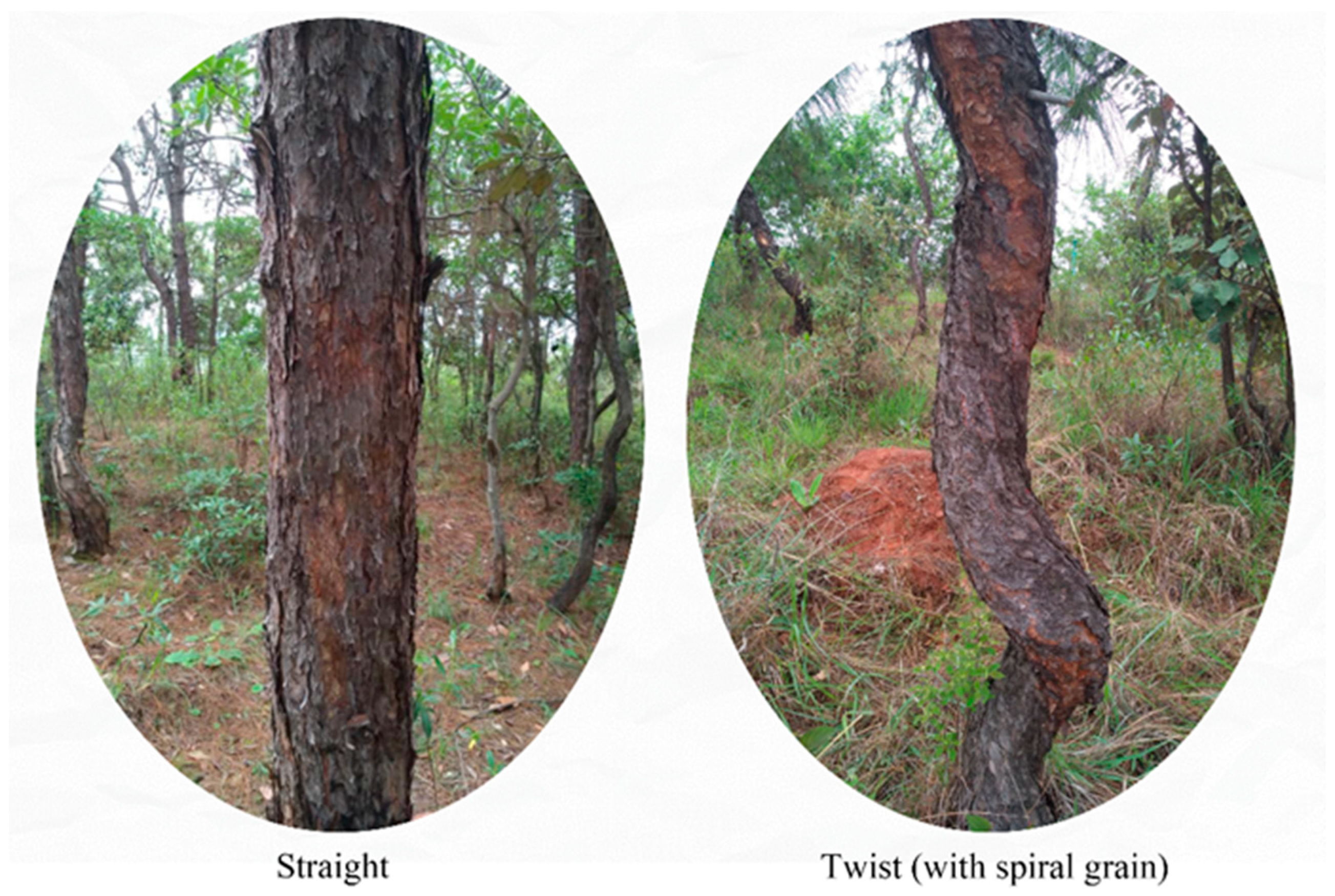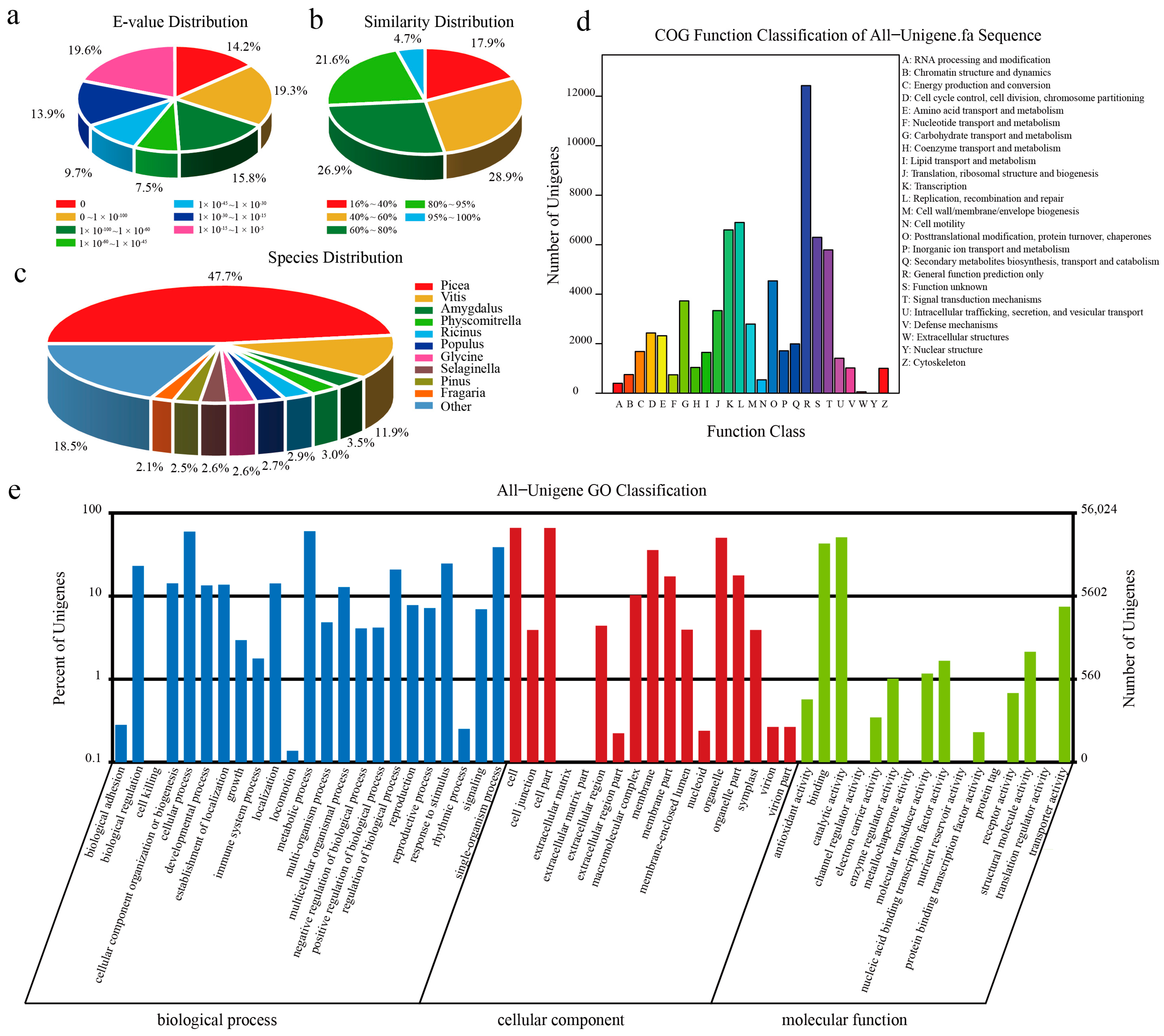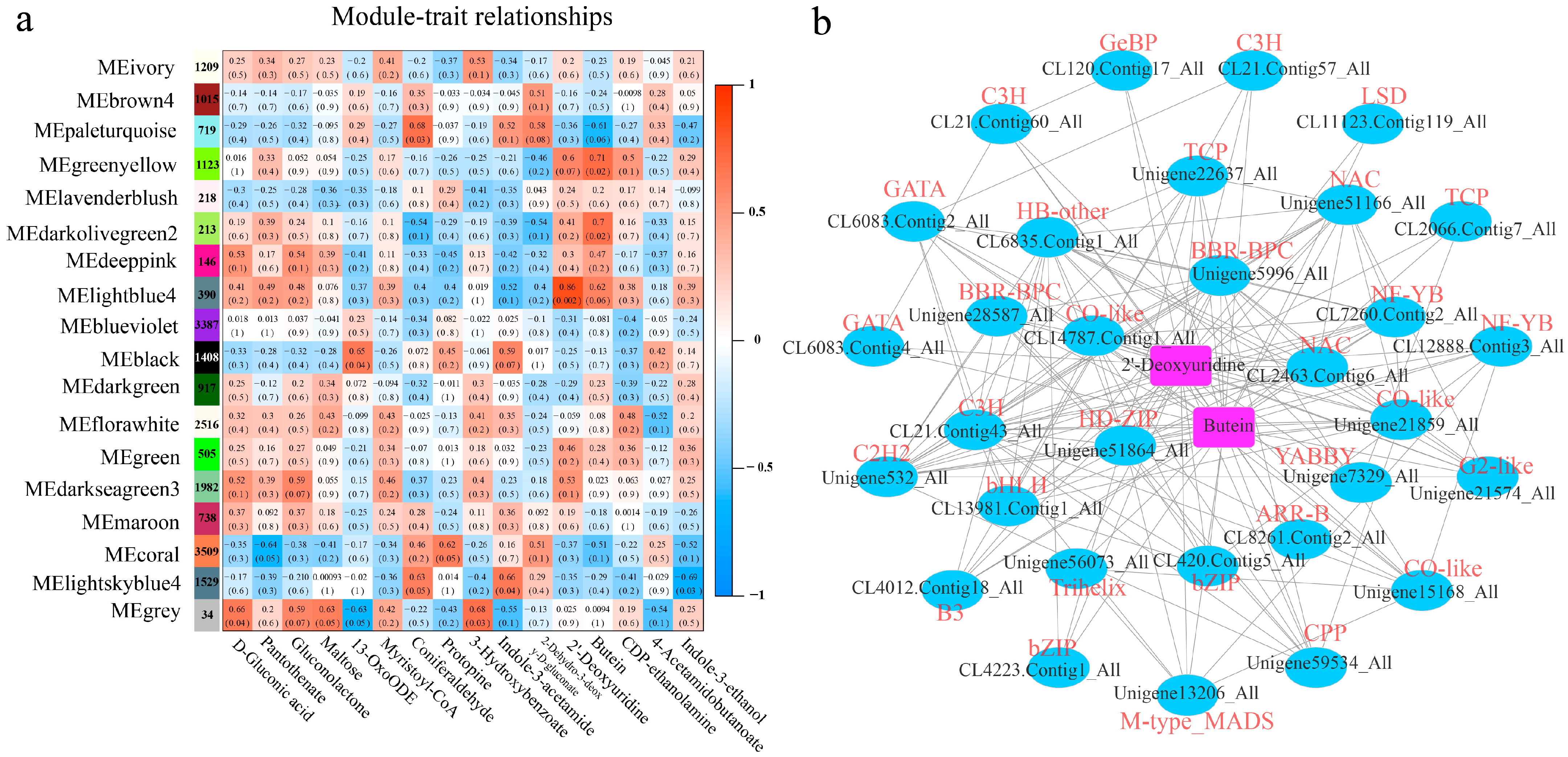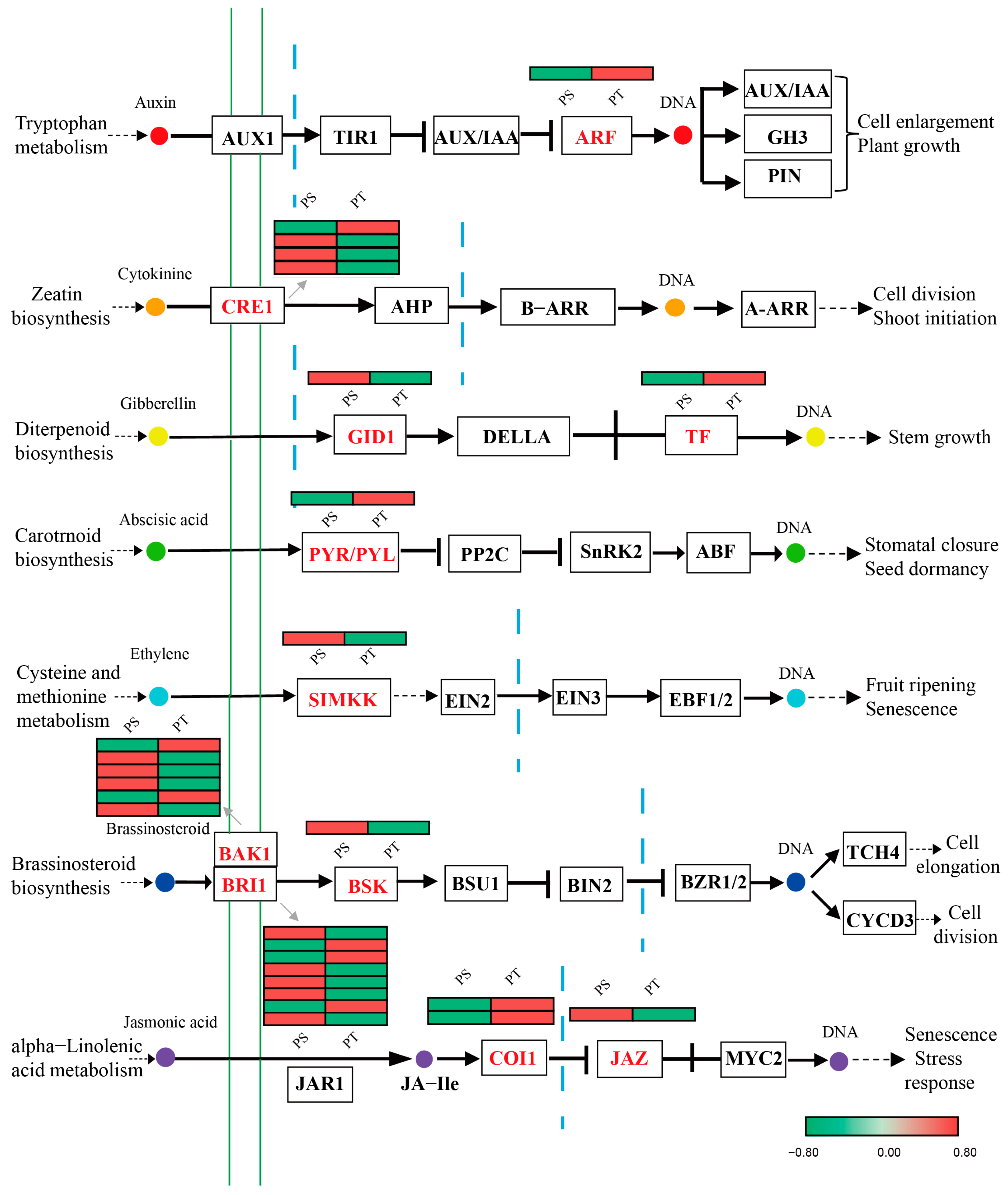Comparative Transcriptomic and Metabolomic Analyses of Differences in Trunk Spiral Grain in Pinus yunnanensis
Abstract
:1. Introduction
2. Results
2.1. De Novo Assembly
2.2. Functional Annotation
2.3. Differential Expression Gene Detection and Screening
2.4. Metabolite Characteristics of P. yunnanensis
2.5. Gene Coexpression Network Construction
2.6. RT-qPCR Verification
3. Discussion
4. Materials and Methods
4.1. Plant Materials
4.2. RNA Isolation and cDNA Library Construction
4.3. RNA-Seq Analysis
4.4. Metabolome Sample Preparation and Analyses
4.5. Coexpression Network Construction
4.6. Quantitative Real-Time Polymerase Chain Reaction
5. Conclusions
Supplementary Materials
Author Contributions
Funding
Data Availability Statement
Acknowledgments
Conflicts of Interest
Abbreviations
| ABC transporters | ATP-binding cassette transporters |
| ABCC2 | ATP-binding cassette subfamily C member 2 |
| ABCG2 | ATP-binding cassette G2 |
| ARF7 | auxin response factor 7 |
| BAK1 | BRI1-associated receptor kinase 1 |
| bHLH | basic helix–loop–helix |
| bZIP | basic leucine zipper |
| C3H | p-coumarate 3-hydroxylase |
| COI1 | coronatine insensitive 1 |
| CRE1 | cytokinin response 1 |
| HD-ZIP | homeodomain leucine zipper |
| KIF11 | kinesin family member 11 |
| NAC | N-acetylcysteine |
| PIF3 | phytocheome-interacting factor 3 |
| RPM1 | resistance to pseudomonas maculicola 1 |
| RPS2 | ribosomal protein S2 |
| 13-HOTE | 13-hydroxyoctadecatrienoic acid |
| 13-OxoODE | 13-oxooctadecadienoic acid |
References
- Mendis, M.S.; Halwatura, R.U.; Somadeva, D.R.K.; Jayasinghe, R.; Gunawardana, M. Influence of timber grain distribution on orientation of saw cuts during application: Reference to heritage structures in Sri Lanka. Case Stud. Constr. Mater. 2019, 11, e00237. [Google Scholar] [CrossRef]
- Harris, J.M. Spiral Grain and Wave Phenomena in Wood Formation; Springer: Berlin/Heidelberg, Germany, 1989; 214p. [Google Scholar]
- Hansen, J.K.; Roulund, H. Spiral grain in a clonal trial with Sitka spruce. Can. J. For. Res. 1998, 28, 911–919. [Google Scholar] [CrossRef]
- Fonweban, J.N.; Mavrou, I.; Gardiner, B.; Macdonald, E. Modelling the effect of spacing and site exposure on spiral grain angle on Sitka spruce (Picea sitchensis (Bong.) Carr.) in Northern Britain. Forestry 2013, 86, 331–342. [Google Scholar] [CrossRef]
- Stevens, W.C.; Johnston, D.D. Distortion caused by spiralled grain. Timber Technol. 1960, 68, 217–218. [Google Scholar]
- Forsberg, D.; Warensjö, M. Grain Angle Variation: A major determinant of twist in sawn Picea abies (L.) Karst. Scand. J. For. Res. 2001, 16, 269–277. [Google Scholar] [CrossRef]
- Hannrup, B.; Grabner, M.; Karlsson, B.; Müller, U.; Rosner, S.; Wilhelmsson, L.; Wimmer, R. Genetic parameters for spiral-grain angle in two 19-year-old clonal Norway spruce trials. Ann. For. Sci. 2002, 59, 551–556. [Google Scholar] [CrossRef]
- Maclaren, P. Internal wood quality of radiata pine on farm sites—A review of the issues. N. Z. J. For. 2002, 47, 24–28. [Google Scholar]
- Danborg, F. Spiral grain in plantation trees of Picea abies. Can. J. For. Res. 1994, 24, 1662–1671. [Google Scholar] [CrossRef]
- Danborg, F. Drying properties and visual grading of juvenile wood from fast grown Picea abies and Picea sitchensis. Scand. J. For. Res. 1994, 9, 91–98. [Google Scholar] [CrossRef]
- Perstorper, M.; Pellicane, P.J.; Kliger, I.R.; Johansson, G. Quality of timber products from Norway spruce. Wood Sci. Technol. 1995, 29, 339. [Google Scholar] [CrossRef]
- Forsberg, D. Shape stability of sawn wood of Norway spruce in relation to site parameters, wood characteristics and market requirements. Med. Phys. 1997, 25, 2046–2053. [Google Scholar]
- Fujimoto, T.; Akutsu, H.; Nei, M.; Kita, K.; Kuromaru, M.; Oda, K. Genetic variation in wood stiffness and strength properties of hybrid larch (Larix gmelinii var. japonica × L. kaempferi). J. For. Res. 2006, 11, 343–349. [Google Scholar] [CrossRef]
- Zobel, B.; Stonecypher, R.W.; Browne, C. Inheritance of spiral grain in young loblolly pine. For. Sci. 1968, 14, 376–379. [Google Scholar]
- Savidge, R.A.; Farrar, J.L. Cellular adjustments in the vascular cambium leading to spiral grain formation in conifers. Can. J. Bot. 1984, 62, 2872–2879. [Google Scholar] [CrossRef]
- Gapare, W.; Hathorn, A.; Kain, D.; Matheson, C.A.; Wu, H. Inheritance of spiral grain in the juvenile core of Pinus radiata. Can. J. For. Res. 2006, 37, 116–127. [Google Scholar] [CrossRef]
- Dumbrell, I.C.; McGrath, J.F. Effect of fertiliser and growth rate on angle of spiral grain in young Pinus radiata in Western Australia. Aust. For. 2000, 63, 142–146. [Google Scholar] [CrossRef]
- Moore, J.R.; Cown, D.J.; Mckinley, R.B. Modelling spiral grain angle variation in New Zealand-grown radiata pine. N. Z. J. For. Sci. 2015, 45, 1–9. [Google Scholar] [CrossRef]
- Silva, J.C.; Borralho, N.; Wellendorf, H. Genetic parameter estimates for diameter growth, pilodyn penetration and spiral grain in Picea abies (L.) Karst. Silvae Genet. 2000, 49, 29–36. [Google Scholar]
- Eklund, L.; Säll, H.; Linder, S. Enhanced growth and ethylene increases spiral grain formation in Picea abies and Abies balsamea trees. Trees 2003, 17, 81–86. [Google Scholar] [CrossRef]
- Włoch, W.; Mazur, E.D.; Bełtowski, M. Formation of spiral grain in the wood of Pinus sylvestris L. Trees 2002, 16, 306–312. [Google Scholar] [CrossRef]
- Eklund, L.; Säll, H. The influence of wind on spiral grain formation in conifer trees. Trees 2000, 14, 324–328. [Google Scholar] [CrossRef]
- Smythies, E.A. Notes on the twisted fibre in Chir Pine. Indian For. 1915, 41, 69–75. [Google Scholar]
- Rault, J.P.; Marsh, E.K. The incidence and silvicultural implications of spiral grain in Pinus longifolia Roxb. In South Africa and Its Effect on Converted Timber, Proceedings of the Commonwealth Forestry Conference, Ottawa, ON, Canada, 11 August 1952; Forestry Products Institute: Pretoria, South Africa, 1952. [Google Scholar]
- Champion, H.G. More about spiral grain in conifers. Indian For. 1929, 55, 57–58. [Google Scholar]
- Skatter, S.; Kučera, B. Spiral grain-An adaptation of trees to withstand stem breakage caused by wind-induced torsion. Holz Als Roh-Und Werkst. 1997, 55, 207–213. [Google Scholar] [CrossRef]
- Zagórska-Marek, B.; Little, C.H.A. Control of fusiform initial orientation in the vascular cambium of Abies balsamea stems by indol-3-ylacetic acid. Can. J. Bot. 1986, 64, 1120–1128. [Google Scholar] [CrossRef]
- Li, S.; Wang, P.; Yuan, W.; Su, Z.; Bullard, S.H. Endocidal Regulation of Secondary Metabolites in the Producing Organisms. Sci. Rep. 2016, 6, 29315. [Google Scholar] [CrossRef]
- Teklić, T.; Parađiković, N.; Špoljarević, M.; Zeljković, S.; Lončarić, Z.; Lisjak, M. Linking abiotic stress, plant metabolites, biostimulants and functional food. Ann. Appl. Biol. 2020, 178, 169–191. [Google Scholar] [CrossRef]
- Jha, Y.; Mohamed, H.I. Plant Secondary Metabolites as a Tool to Investigate Biotic Stress Tolerance in Plants: A Review. Gesunde Pflanz. 2022, 74, 771–790. [Google Scholar] [CrossRef]
- Yang, F.; Shen, H.; Huang, T.; Yao, Q.; Hu, J.; Tang, J.; Zhang, R.; Tong, H.; Wu, Q.-J.; Zhang, Y.J.; et al. Flavonoid production in tomato mediates both direct and indirect plant defences against whiteflies in tritrophic interactions. Pest Manag. Sci. 2023. [Google Scholar] [CrossRef]
- Keswani, C.; Singh, H.B.; García-Estrada, C.; Caradus, J.R.; He, Y.-W.; Mezaache-Aichour, S.; Glare, T.R.; Borriss, R.; Sansinenea, E. Antimicrobial secondary metabolites from agriculturally important bacteria as next-generation pesticides. Appl. Microbiol. Biotechnol. 2019, 104, 1013–1034. [Google Scholar] [CrossRef]
- Huang, P.; Lin, F.; Li, B.; Zheng, Y. Hybrid-Transcriptome Sequencing and Associated Metabolite Analysis Reveal Putative Genes Involved in Flower Color Difference in Rose Mutants. Plants 2019, 8, 267. [Google Scholar] [CrossRef] [PubMed]
- Ku, Y.-S.; Contador, C.A.; Ng, M.-S.; Yu, J.; Chung, G.; Lam, H.-M. The Effects of Domestication on Secondary Metabolite Composition in Legumes. Front. Genet. 2020, 11, 581357. [Google Scholar] [CrossRef] [PubMed]
- Oh, J.; Cho, I.H. The aroma profile and aroma-active compounds of Brassica oleracea (kale) tea. Food Sci. Biotechnol. 2021, 30, 1205–1211. [Google Scholar] [CrossRef] [PubMed]
- Chevalier, W.; Moussa, S.A.; Ottoni, M.M.N.; Dubois-Laurent, C.; Huet, S.; Aubert, C.; Desnoues, E.; Navez, B.; Cottet, V.; Chalot, G. Multisite evaluation of phenotypic plasticity for specialized metabolites, some involved in carrot quality and disease resistance. PLoS ONE 2021, 16, e0249613. [Google Scholar] [CrossRef] [PubMed]
- Bano, C.; Singh, N.B.; Sunaina, S. Differential responses of pea seedlings to salicylic acid under UV-B stress. Trop. Plant Res. 2016, 3, 586–591. [Google Scholar] [CrossRef]
- Bano, C.; Amist, N.; Sunaina; Singh, N. B. UV-B radiation escalate allelopathic effect of benzoic acid on Solanum lycopersicum L. Sci. Hortic. 2017, 220, 199–205. [Google Scholar] [CrossRef]
- Chiappero, J.; Cappellari, L.D.R.; Palermo, T.B.; Giordano, W.; Banchio, E. Antioxidant status of medicinal and aromatic plants under the influence of growth-promoting rhizobacteria and osmotic stress. Ind. Crops Prod. 2021, 167, 113541. [Google Scholar] [CrossRef]
- Zhou, R.; Kong, L.; Yu, X.; Ottosen, C.O.; Zhao, T.; Jiang, F.; Wu, Z. Oxidative damage and antioxidant mechanism in tomatoes responding to drought and heat stress. Acta Physiol. Plant. 2019, 41, 1–11. [Google Scholar] [CrossRef]
- Wang, F.; Sethiya, P.; Hu, X.; Guo, S.; Chen, Y.; Li, A.; Tan, K.; Wong, K.H. Transcription in fungal conidia before dormancy produces phenotypically variable conidia that maximize survival in different environments. Nat. Microbiol. 2021, 6, 1066–1081. [Google Scholar] [CrossRef]
- Xu, Y.L.; Zhang, R.L.; Tian, B.; Bai, Q.S.; Wang, D.W.; Cai, N.H.; He, C.Z.; Kang, X.Y.; Duan, A.A. Development of novel microsatellite markers for Pinus yunnanensis and their cross amplification in congeneric species. Conserv. Genet. Resour. 2013, 5, 1113–1114. [Google Scholar] [CrossRef]
- Conesa, A.; Götz, S. Blast2GO: A Comprehensive suite for functional analysis in plant genomics. Int. J. Plant Genom. 2008, 2008, 12. [Google Scholar] [CrossRef] [PubMed]
- Wang, J.; Zhang, T.; Shen, X.; Liu, J.; Zhao, D.; Sun, Y.; Wang, L.; Liu, Y.; Gong, X.; Liu, Y.; et al. Serum metabolomics for early diagnosis of esophageal squamous cell carcinoma by UHPLC-QTOF/MS. Metabolomics 2016, 12, 1–10. [Google Scholar] [CrossRef]
- Yang, J.; Bak, G.; Burgin, T.; Barnes, W.J.; Mayes, H.B.; Peña, M.J.; Urbanowicz, B.R.; Nielsen, E. Biochemical and genetic analysis identify CSLD3 as a beta-1,4-glucan synthase that functions during plant cell wall synthesis. Plant Cell 2020, 32, 1749–1767. [Google Scholar] [CrossRef] [PubMed]
- Schneider, R.; Hanak, T.; Persson, S.; Voigt, C.A. Cellulose and callose synthesis and organization in focus, what’s new? Curr. Opin. Plant Biol. 2016, 34, 9–16. [Google Scholar] [CrossRef]
- Lei, L.; Li, S.; Du, J.; Bashline, L.; Gu, Y. Cellulose synthase interactive3 regulates cellulose biosynthesis in both a microtubule-dependent and microtubule-independent manner in Arabidopsis. Plant Cell 2013, 25, 4912–4923. [Google Scholar] [CrossRef]
- Carpita, N.C.; Gibeaut, D.M. Structural models of primary cell walls in flowering plants: Consistency of molecular structure with the physical properties of the walls during growth. Plant J. 1993, 3, 1–30. [Google Scholar] [CrossRef]
- Wasteneys, G.O. Progress in understanding the role of microtubules in plant cells. Curr. Opin. Plant Biol. 2005, 7, 651–660. [Google Scholar] [CrossRef]
- Sedbrook, J.C.; Ehrhardt, D.W.; Fisher, S.E.; Scheible, W.R.; Somerville, C.R. The Arabidopsis sku6/spiral1 gene encodes a plus end-localized microtubule-interacting protein involved in directional cell expansion. Plant Cell 2004, 16, 1506–1520. [Google Scholar] [CrossRef]
- Nakajima, K.; Furutani, I.; Tachimoto, H.; Matsubara, H.; Hashimoto, T. SPIRAL1 encodes a plant-specific microtubule-localized protein required for directional control of rapidly expanding Arabidopsis cells. Plant Cell Online 2004, 16, 1178–1190. [Google Scholar] [CrossRef]
- Sakai, T.; Honing, H.; Nishioka, M.; Uehara, Y.; Takahashi, M.; Fujisawa, N.; Saji, K.; Seki, M.; Shinozaki, K.; Jones, M.A. Armadillo repeat-containing kinesins and a NIMA-related kinase are required for epidermal-cell morphogenesis in Arabidopsis. Plant J. Cell Mol. Biol. 2008, 53, 157–171. [Google Scholar] [CrossRef]
- Bringmann, M.; Li, E.; Sampathkumar, A.; Kocabek, T.; Persson, H.S. POM-POM2/CELLULOSE SYNTHASE INTERACTING1 is essential for the functional association of cellulose synthase and microtubules in Arabidopsis. Plant Cell 2012, 24, 163–177. [Google Scholar] [CrossRef] [PubMed]
- Bisgrove, S.R.; Lee, Y.R.J.; Liu, B.; Peters, N.T.; Kropf, D.L. The microtubule plus-end binding protein EB1 functions in root responses to touch and gravity signals in Arabidopsis. Plant Cell 2008, 20, 396–410. [Google Scholar] [CrossRef] [PubMed]
- Whittington, A.T.; Vugrek, O.; Wei, K.J.; Hasenbein, N.G.; Sugimoto, K.; Rashbrooke, M.C.; Wasteneys, G.O. MOR1 is essential for organizing cortical microtubules in plants. Nature 2001, 411, 610–613. [Google Scholar] [CrossRef]
- Furutani, I.; Watanabe, Y.; Prieto, R.; Masukawa, M.; Hashimoto, T. The SPIRAL genes are required for directional control of cell elongation in Aarabidopsis thaliana. Development 2000, 127, 4443–4453. [Google Scholar] [CrossRef]
- Buschmann, H.; Fabri, C.O.; Hauptmann, M.; Hutzler, P.; Laux, T.; Lloyd, C.W.; Schäffner, A.R. Helical growth of the Arabidopsis mutant tortifolia1 reveals a plant-specific microtubule-associated protein. Curr. Biol. 2004, 14, 1515–1521. [Google Scholar] [CrossRef]
- Saffer, A.M.; Carpita, N.C.; Irish, V.F. Rhamnose-containing cell wall polymers suppress helical plant growth independently of microtubule orientation. Curr. Biol. 2017, 27, 2248–2259. [Google Scholar] [CrossRef] [PubMed]
- Yuen, C.; Sedbrook, J.C.; Perrin, R.M.; Carroll, K.L.; Masson, P.H. Loss-of-function mutations of ROOT HAIR DEFECTIVE3 suppress root waving, skewing, and epidermal cell file rotation in Arabidopsis. Plant Physiol. 2005, 138, 701–714. [Google Scholar] [CrossRef]
- Sedbrook, J.C.; Carroll, K.L.; Hung, K.F.; Masson, P.H.; Somerville, C.R. The Arabidopsis SKU5 gene encodes an extracellular glycosyl phosphatidylinositol-anchored glycoprotein involved in directional root growth. Plant Cell. 2002, 14, 1635–1648. [Google Scholar] [CrossRef]
- Cui, D.; Neill, S.J.; Tang, Z.; Cai, W. Gibberellin-regulated XET is differentially induced by auxin in rice leaf sheath bases during gravitropic bending. J. Exp. Bot. 2005, 56, 1327–1334. [Google Scholar] [CrossRef]
- Chen, L.; Higashitani, A.; Suge, H.; Takeda, K.; Takahashi, H. Spiral growth and cell wall properties of the gibberellin-treated first internodes in the seedlings of a wheat cultivar tolerant to deep-sowing conditions. Physiol. Plant. 2003, 118, 147–155. [Google Scholar] [CrossRef]
- Eklund, L.; Little, C. Interaction between indole-3-acetic acid and ethylene in the control of tracheid production in detached shoots of Abies balsamea. Tree Physiol. 1995, 15, 27–34. [Google Scholar] [CrossRef]
- Han, J.W.; Choi, G.J.; Kim, B.S. Antimicrobial aromatic polyketides: A review of their antimicrobial properties and potential use in plant disease control. World J. Microbiol. Biotechnol. 2018, 34, 163. [Google Scholar] [CrossRef] [PubMed]
- Yudkina, A.V.; Kovalenko, E.A.; Endutkin, A.V.; Panferova, E.P.; Kirilenko, A.A.; Kokhanenko, A.A.; Zharkov, D.O. Factors Affecting the Stability of the Trimer of 2′-Deoxyuridine 5′-Triphosphate Nucleotide Hydrolase from Escherichia coli. Mol. Biol. 2023, 57, 312–319. [Google Scholar] [CrossRef]
- Li, P.L.; Zong, D.; Gan, P.H.; Li, H.L.; Wu, Z.Y.; Li, F.H.; Zhao, C.L.; Li, L.G.; He, C.Z. Comparison of the diversity and structure of the rhizosphere microbial community between the straight and twisted trunk types of Pinus yunnanensis. Front. Microbiol. 2023, 14, 1066805. [Google Scholar] [CrossRef] [PubMed]
- Jones, J.D.G.; Dangl, J.L. The plant immune system. Nature 2006, 444, 323–329. [Google Scholar] [CrossRef] [PubMed]
- Jones, D.A.; Takemoto, D. Plant innate immunity-direct and indirect recognition of general and specific pathogen-associated molecules. Curr. Opin. Immunol. 2004, 16, 48–62. [Google Scholar] [CrossRef]
- Kim, M.G.; Cunha, L.D.; McFall, A.J.; Belkhadir, Y.; DebRoy, S.; Dangl, J.L.; Mackey, D. Two Pseudomonas syringae type III effectors inhibit RIN4-regulated basal defense in Arabidopsis. Cell 2005, 121, 749–759. [Google Scholar] [CrossRef]
- Qi, Y.; Tsuda, K.; Glazebrook, J.; Katagiri, F. Physical association of pattern-triggered immunity (PTI) and effector-triggered immunity (ETI) immune receptors in Arabidopsis. Mol. Plant Pathol. 2011, 12, 702–708. [Google Scholar] [CrossRef]
- Gómez-Gómez, L.; Boller, T.J.M.C. FLS2: An LRR receptor-like kinase involved in the perception of the bacterial elicitor flagellin in Arabidopsis. Mol. Cell 2000, 5, 1003–1011. [Google Scholar] [CrossRef]
- Grabherr, M.G.; Haas, B.J.; Yassour, M.; Levin, J.Z.; Thompson, D.A.; Amit, I.; Adiconis, X.; Fan, L.; Raychowdhury, R.; Zeng, Q.; et al. Full-length transcriptome assembly from RNA-Seq data without a reference genome. Nat. Biotechnol. 2011, 29, 644–652. [Google Scholar] [CrossRef]
- Pertea, G.; Huang, X.; Liang, F.; Antonescu, V.; Sultana, R.; Karamycheva, S.; Lee, Y.; White, J.; Cheung, F.; Parvizi, B.; et al. TIGR Gene Indices clustering tools (TGICL): A software system for fast clustering of large EST datasets. Bioinformatics 2003, 19, 651–652. [Google Scholar] [CrossRef]
- Cameron, M.; Williams, H.E.; Cannane, A. Improved gapped alignment in BLAST. IEEE/ACM Trans. Comput. Biol. Bioinform. 2004, 1, 116–129. [Google Scholar] [CrossRef]
- Wang, L.; Feng, Z.; Wang, X.; Wang, X.; Zhang, X. DEGseq: An R package for identifying differentially expressed genes from RNA-seq data. Bioinformatics 2010, 26, 136–138. [Google Scholar] [CrossRef]
- Chen, C.; Chen, H.; Zhang, Y.; Thomas, H.R.; Frank, M.H.; He, Y.; Xia, R. TBtools—An integrative toolkit developed for interactive analyses of big biological data. Mol. Plant 2020, 13, 1194–1202. [Google Scholar] [CrossRef] [PubMed]
- Wickham, H. Elegant graphics for data analysis. Media 2009, 35, 10–1007. [Google Scholar]
- Langfelder, P.; Horvath, S. WGCNA: An R package for weighted correlation network analysis. BMC Bioinform. 2008, 9, 559. [Google Scholar] [CrossRef]
- Cline, M.S.; Smoot, M.E.; Cerami, E.G.; Kuchinsky, A.; Landys, N.; Workman, C.; Christmas, R.H.; Avila-Campilo, I.; Creech, M.L.; Gross, B.E.; et al. Integration of biological networks and gene expression data using Cytoscape. Nat. Protoc. 2007, 2, 2366–2382. [Google Scholar] [CrossRef] [PubMed]
- Granados, J.M.; Ávila, C.; Cánovas, F.M.; Cañas, R.A. Genomes, selection and testing of reference genes for accurate RT-qPCR in adult needles and seedlings of maritime pine. Tree Genet. 2016, 12, 1–15. [Google Scholar]
- Lalitha, S. Primer Premier 5. Biotech Softw. Internet Rep. Comput. Softw. J. Sci. 2000, 1, 270–272. [Google Scholar] [CrossRef]
- Livak, K.J.; Schmittgen, T. Analysis of relative gene expression data using real-time quantitative PCR and the 2−ΔΔCT method. Methods 2001, 25, 402–408. [Google Scholar] [CrossRef]







Disclaimer/Publisher’s Note: The statements, opinions and data contained in all publications are solely those of the individual author(s) and contributor(s) and not of MDPI and/or the editor(s). MDPI and/or the editor(s) disclaim responsibility for any injury to people or property resulting from any ideas, methods, instructions or products referred to in the content. |
© 2023 by the authors. Licensee MDPI, Basel, Switzerland. This article is an open access article distributed under the terms and conditions of the Creative Commons Attribution (CC BY) license (https://creativecommons.org/licenses/by/4.0/).
Share and Cite
Gan, P.; Li, P.; Zhang, X.; Li, H.; Ma, S.; Zong, D.; He, C. Comparative Transcriptomic and Metabolomic Analyses of Differences in Trunk Spiral Grain in Pinus yunnanensis. Int. J. Mol. Sci. 2023, 24, 14658. https://doi.org/10.3390/ijms241914658
Gan P, Li P, Zhang X, Li H, Ma S, Zong D, He C. Comparative Transcriptomic and Metabolomic Analyses of Differences in Trunk Spiral Grain in Pinus yunnanensis. International Journal of Molecular Sciences. 2023; 24(19):14658. https://doi.org/10.3390/ijms241914658
Chicago/Turabian StyleGan, Peihua, Peiling Li, Xiaolin Zhang, Hailin Li, Shaojie Ma, Dan Zong, and Chengzhong He. 2023. "Comparative Transcriptomic and Metabolomic Analyses of Differences in Trunk Spiral Grain in Pinus yunnanensis" International Journal of Molecular Sciences 24, no. 19: 14658. https://doi.org/10.3390/ijms241914658




